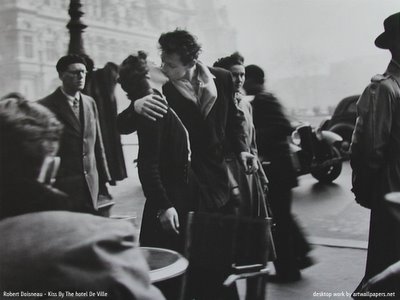Bending the truth
Robert Doisneau, Le Basier de L'hotel de Ville, 1950
The photo above was shown to me by a friend while we were having a discussion on the honesty of art and art forms. I won't go into the entirety of the conversation here, simply because it is unnecessary. Like most of my conversations with Mic it ended unresovled, just the way I like it! Since then I have been keeping this photo as the background and contemplating the meaning of it.
The photographer, Robert Doisneau is a well known French photographer who took pictures of everyday life on the streets of Paris. he did this for years and got plenty of great shots. The Kiss by the Hotel de Ville happens to be his most famous. It was a symbol of pure uninhibited romance captured by the camera. Now the true question is; since it is a photograph, which is a picture of something that really happened, is it telling us what really happened? Most people want to believe it is. Afterall it would be happier to think of this photo as the capturing of a secret moment between two people. It helps support the yerning for the belief in true romance. Which I would like to think was the point of this photo.
The real truth is that this couple are not a couple at all; they are a hired pair of models. They were paid to do it. Which means the embrace was not one of romance but one of money. It's a falsification of the truth, it manipulates its audience. In this way it plays up to all art form by bringing on a reaction.
The true moral of this whole rant is that what you are presented with is always a biased representation of the truth. As this it should always be second guessed, in thought if not in action. Unless of course you're happy being given an altered truth, sometimes that's just easier to accept than reality.

5 Comments:
I would argue that even if those were two random people passionately kissing on the street and caught by the lens, it is still not a true representation of life; art photography is still art. Doisneau is presenting his reality. With attention to where the dark and the light fall, to what is blurred and what is crisp, and all of those other tiny details that manipulate the way that we view the photograph, with or without our conscious recognition of that manipulation, he's inviting us to the scene in a certain way. If the same two models were posed in the corner of the photograph, with the background people moving away (the same scene from a different angle) it would capture entirely different emotions, and would be an entirely different representation of reality. Whether they are models, or real people, the contrivance of art is still there. Right?
P.S. I hate you Boothie, for your procrastination-encouraging ways!!
P.P.S. But I still love you.
This is true, which is why I find photography itself so dissapointing. It can come so close to the truth but never quite reveal it.
P.S. Connie you love it, you know you do... in truth... I do this for you! *MWA*
On the other hand; Doisneau is not trying to present the visual objective truth of two specific people kissing on the street. He is trying to represent an idea; the essence of romance, love, and freedom. Each individual couple is just a small piece, and a very imperfect shadow, of that much larger ideal. Using hired models, and light, shadow, dimension, and all of the other technical tricks of photography, Doisneau is representing the truth of pure, uninhibited romance. It's no one in specific, and could be anyone. And isn't that a greater truth than the reality of two people on the street?
It is not an altered reality, because it is not supposed to be objective reality. It's idealistic. But it is still true. We've all had those moments, and they are incredibly real, albeit elusive and fleeting.
I like the photograph a lot. More than romance, it's a representation of hope, and freedom. It is not a soldier kissing his girlfriend goodbye, it's two people who are able to kiss, and keep walking together. In the 1950s, that would have meant something.
I had seen that photograph (or heard of Doisneau) until now. How educational your blog is!
Oops, I meant I have NEVER seen that photograph until now.
How is it manipulative to mass produce the photograph? Perhaps capitalistic and materialistic, but..manipulative?
There is art that tries to address social and political problems, and there is escapism., and the two don't need to be opposed to one another; by turning directly away from a problem, you are paradoxically still acknowledging that it exists. By specifically not looking at something, you are admitting that there is something not to be looked at.
To paraphrase Adorno, "Can there be art after Auschwitz?"
I don't think that Doisneau is necessarily being disrespectful to the war that had just ended, and all of those who died. He is not necessarily falsifying life in Paris in 1950, or trying to present a false, idealistic reality. I think that he is only suggesting that life can still be worthwhile for those who survived, and that hope and romance can still exist in a post-Auschwitz world.
Damn this blog. >:|
Post a Comment
<< Home